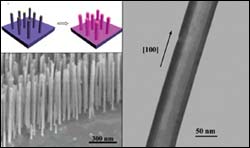USC scientist invents technique to grow superconducting and magnetic ’nanocables’

Top left, schematic diagram of process. Bottom left, MgO nanowires ready for coating. Right, completed Fe304 nanocable. <br>
’we can supply a group of previously unavailable materials to the nanotechnology community’
A University of Southern California engineer has discovered a way to manufacture composite “nanocables” from a potent new class of substances with extraordinary properties called Transition Metal Oxides (TMOs).
Chongwu Zhou, an assistant professor in the USC Viterbi School of Engineering’s Department of Electrical Engineering, is creating dense arrays of ultrafine wires made of magnesium oxide (MgO), each coated with uniform, precisely controlled layers of TMO.
In the last decade, TMOs have come under intense investigation because they demonstrate a wide range of potentially highly useful properties including high-temperature superconductivity. Because of the great potential for applications and research, investigators have tried for years to create TMO nanowires, but have so far had limited success. “But now we can supply a group of previously unavailable materials to the nanotechnology community,” Zhou said.
The Zhou team demonstrated the technique with four different TMOs: YBCO, a well-known superconductor with a high transition temperature; LCMO, a material showing “colossal” magnetoresistance; PZT, an important ferroelectric material; and Fe3O4, known as magnetite in its strongly magnetic mineral form.
The new structures all start with a new technique Zhou and his co-workers developed to create arrays of nanowires by condensing MgO vapor onto MgO plates using gold as catalyst. This leads to a forest of MgO nanowires, each 30-100 nanometers in diameter and 3 microns (100 millionth of an inch) long, all growing parallel fashion, at a constant angle to the substrate plate.
“Now the magic starts,” Zhou says. A laser vaporizes the TMO, which then condenses directly out of the gaseous state onto the waiting MgO cores in very precise fashion, a process called “pulsed laser deposition.”
The final product looks like nano-sized coaxial cable, with an MgO core and TMO sheath. “The trick is we can preserve the TMO composition using this technique,” says Zhou, “while other techniques cannot.”
Zhou wrote in a paper recently accepted for publication in Nano Letters and now circulating on the Internet, that the assemblies “can be tailored for a wide variety of applications, including low-loss power delivery, quantum computing, ultrahigh density magnetic data storage, and more recently, spintronic applications.”
“We … expect that these TMO nanowires may offer enormous opportunities to explore intriguing physics at the nanoscale dimensions.”
Zhou, the winner of the Viterbi School of Engineering’s 2004 Junior Faculty Research Award, believes that the four new nanowires are only the beginning. “Our synthetic approach will lead to other new nanostructures,” he said.
Working with Zhou were Song Han, Chao Li, Zuqin Liu, Bo Lei, Daihua Zhang, Wu Jin, Xiaoleiu Liu, and Tao Tang. A National Science Foundation CAREER award and DARPA supported the research.
Media Contact
More Information:
http://www.usc.eduAll latest news from the category: Power and Electrical Engineering
This topic covers issues related to energy generation, conversion, transportation and consumption and how the industry is addressing the challenge of energy efficiency in general.
innovations-report provides in-depth and informative reports and articles on subjects ranging from wind energy, fuel cell technology, solar energy, geothermal energy, petroleum, gas, nuclear engineering, alternative energy and energy efficiency to fusion, hydrogen and superconductor technologies.
Newest articles

NASA: Mystery of life’s handedness deepens
The mystery of why life uses molecules with specific orientations has deepened with a NASA-funded discovery that RNA — a key molecule thought to have potentially held the instructions for…

What are the effects of historic lithium mining on water quality?
Study reveals low levels of common contaminants but high levels of other elements in waters associated with an abandoned lithium mine. Lithium ore and mining waste from a historic lithium…

Quantum-inspired design boosts efficiency of heat-to-electricity conversion
Rice engineers take unconventional route to improving thermophotovoltaic systems. Researchers at Rice University have found a new way to improve a key element of thermophotovoltaic (TPV) systems, which convert heat…



